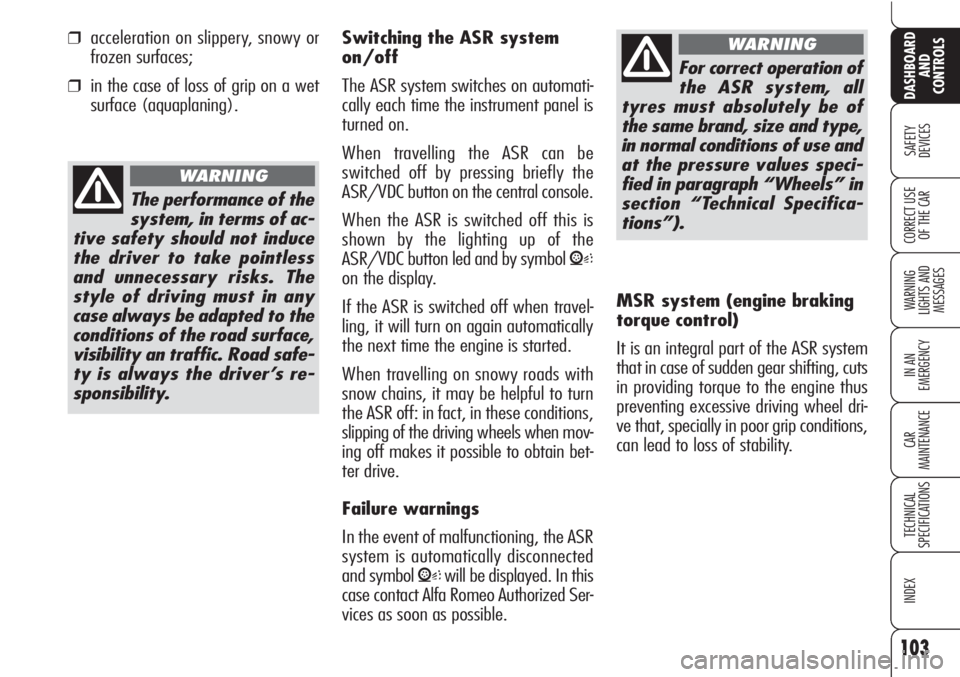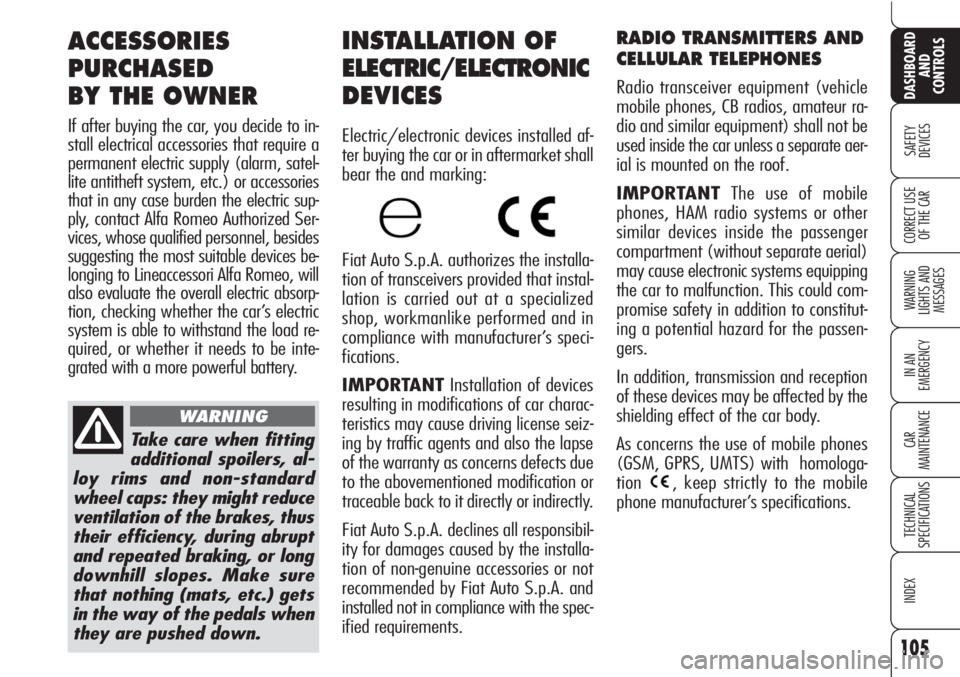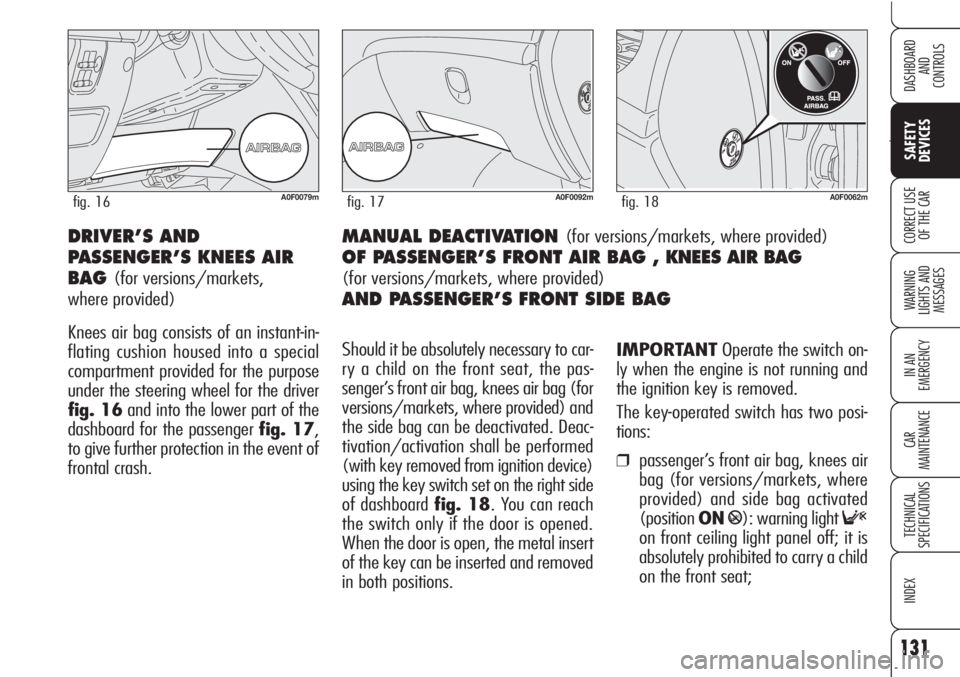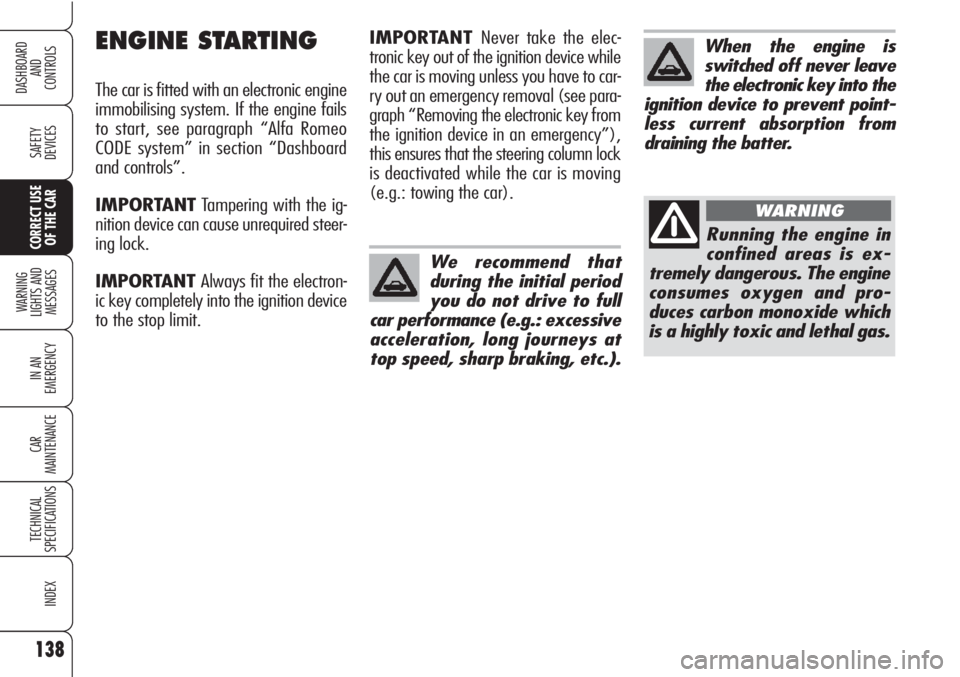2010 Alfa Romeo Brera/Spider ABS
[x] Cancel search: ABSPage 105 of 271

103
SAFETY
DEVICES
WARNING
LIGHTS AND
MESSAGES
IN AN
EMERGENCY
CAR
MAINTENANCE
TECHNICAL
SPECIFICATIONS
INDEX
DASHBOARD
AND
CONTROLS
CORRECT USE
OF THE CAR
❒acceleration on slippery, snowy or
frozen surfaces;
❒in the case of loss of grip on a wet
surface (aquaplaning).
The performance of the
system, in terms of ac-
tive safety should not induce
the driver to take pointless
and unnecessary risks. The
style of driving must in any
case always be adapted to the
conditions of the road surface,
visibility an traffic. Road safe-
ty is always the driver’s re-
sponsibility.
WARNING
Switching the ASR system
on/off
The ASR system switches on automati-
cally each time the instrument panel is
turned on.
When travelling the ASR can be
switched off by pressing briefly the
ASR/VDC button on the central console.
When the ASR is switched off this is
shown by the lighting up of the
ASR/VDC button led and by symbol
V
on the display.
If the ASR is switched off when travel-
ling, it will turn on again automatically
the next time the engine is started.
When travelling on snowy roads with
snow chains, it may be helpful to turn
the ASR off: in fact, in these conditions,
slipping of the driving wheels when mov-
ing off makes it possible to obtain bet-
ter drive.
Failure warnings
In the event of malfunctioning, the ASR
system is automatically disconnected
and symbol
Vwill be displayed. In this
case contact Alfa Romeo Authorized Ser-
vices as soon as possible.
For correct operation of
the ASR system, all
tyres must absolutely be of
the same brand, size and type,
in normal conditions of use and
at the pressure values speci-
fied in paragraph “Wheels” in
section “Technical Specifica-
tions”).
WARNING
MSR system (engine braking
torque control)
It is an integral part of the ASR system
that in case of sudden gear shifting, cuts
in providing torque to the engine thus
preventing excessive driving wheel dri-
ve that, specially in poor grip conditions,
can lead to loss of stability.
Page 107 of 271

105
SAFETY
DEVICES
WARNING
LIGHTS AND
MESSAGES
IN AN
EMERGENCY
CAR
MAINTENANCE
TECHNICAL
SPECIFICATIONS
INDEX
DASHBOARD
AND
CONTROLS
CORRECT USE
OF THE CAR
RADIO TRANSMITTERS AND
CELLULAR TELEPHONES
Radio transceiver equipment (vehicle
mobile phones, CB radios, amateur ra-
dio and similar equipment) shall not be
used inside the car unless a separate aer-
ial is mounted on the roof.
IMPORTANTThe use of mobile
phones, HAM radio systems or other
similar devices inside the passenger
compartment (without separate aerial)
may cause electronic systems equipping
the car to malfunction. This could com-
promise safety in addition to constitut-
ing a potential hazard for the passen-
gers.
In addition, transmission and reception
of these devices may be affected by the
shielding effect of the car body.
As concerns the use of mobile phones
(GSM, GPRS, UMTS) with homologa-
tion , keep strictly to the mobile
phone manufacturer’s specifications.
ACCESSORIES
PURCHASED
BY THE OWNER
If after buying the car, you decide to in-
stall electrical accessories that require a
permanent electric supply (alarm, satel-
lite antitheft system, etc.) or accessories
that in any case burden the electric sup-
ply, contact Alfa Romeo Authorized Ser-
vices, whose qualified personnel, besides
suggesting the most suitable devices be-
longing to Lineaccessori Alfa Romeo, will
also evaluate the overall electric absorp-
tion, checking whether the car’s electric
system is able to withstand the load re-
quired, or whether it needs to be inte-
grated with a more powerful battery.
Take care when fitting
additional spoilers, al-
loy rims and non-standard
wheel caps: they might reduce
ventilation of the brakes, thus
their efficiency, during abrupt
and repeated braking, or long
downhill slopes. Make sure
that nothing (mats, etc.) gets
in the way of the pedals when
they are pushed down.
WARNING
INSTALLATION OF
ELECTRIC/ELECTRONIC
DEVICES
Electric/electronic devices installed af-
ter buying the car or in aftermarket shall
bear the and marking:
Fiat Auto S.p.A. authorizes the installa-
tion of transceivers provided that instal-
lation is carried out at a specialized
shop, workmanlike performed and in
compliance with manufacturer’s speci-
fications.
IMPORTANTInstallation of devices
resulting in modifications of car charac-
teristics may cause driving license seiz-
ing by traffic agents and also the lapse
of the warranty as concerns defects due
to the abovementioned modification or
traceable back to it directly or indirectly.
Fiat Auto S.p.A. declines all responsibil-
ity for damages caused by the installa-
tion of non-genuine accessories or not
recommended by Fiat Auto S.p.A. and
installed not in compliance with the spec-
ified requirements.
Page 108 of 271

106
SAFETY
DEVICES
WARNING
LIGHTS AND
MESSAGES
IN AN
EMERGENCY
CAR
MAINTENANCE
TECHNICAL
SPECIFICATIONS
INDEX
DASHBOARD
AND
CONTROLS
CORRECT USE
OF THE CAR
PARKING SENSORS
(for versions/markets, where provided)
Parking sensors inform the driver about
the presence of obstacles behind the car.
This system is therefore an aid for the
driver when parking the car since it de-
tects obstacles out of the driver’s sight
range.
The presence and the distance from the
car of an obstacle is indicated by a warn-
ing buzzer - as the distance from the ob-
stacle decreases, the acoustic alarm be-
comes more frequent.Parking manoeuvres
however are always
under the driver’s responsibil-
ity that shall always check the
absence of people (specially
children) or animals in the ma-
noeuvre space. This system is
just a help for the driver but
she/he shall never reduce at-
tention during dangerous ma-
noeuvres even if performed at
low speed.
WARNINGACTIVATION
Sensors are activated automatically,
with electronic key fitted into the igni-
tion device, when the reverse gear is en-
gaged.
Sensors will deactivate when exceeding
18 km/h.
When sensors are on, rear indicators will
sound warning signals as soon as an ob-
stacle is detected: as the distance from
the obstacle decreases, the acoustic
alarm becomes more frequent.
When the distance between the car and
the obstacle is less than 30 cm, the
acoustic alarm becomes continuous.
The acoustic alarm will stop immediately
as distance raises. The acoustic alarm is
constant if the distance measured by
central sensors is unvaried, whereas if
this situation takes place for side sen-
sors the acoustic alarm is muted after
about 3 seconds to prevent sound indi-
cations when performing manoeuvres
near walls.
Page 115 of 271

113
SAFETY
DEVICES
WARNING
LIGHTS AND
MESSAGES
IN AN
EMERGENCY
CAR
MAINTENANCE
TECHNICAL
SPECIFICATIONS
INDEX
DASHBOARD
AND
CONTROLS
CORRECT USE
OF THE CAREMERGENCY OPENING
OF THE FUEL FILLER CAP
In case of failure, the fuel filler cap can
be opened by pulling string set on the
right side of the boot fig. 88.
A0F0130mfig. 88
FUEL FILLER CAP
The fuel tank lid can only be opened
with doors unlocked and engine
switched off.
Opening
Open the flap A-fig. 87by means of
front part (see figure), turn cap Banti-
clockwise and extract it. The cap has a
deviceCretaining it to the flap so it can-
not be lost. When refuelling, attach the
cap to the flap, as illustrated.
Closing
Fit cap Bin its housing and turn it clock-
wise until it clicks once or more, then close
the flap A.
IMPORTANTThe sealing of the tank
may cause light pressurising in the tank.
A little breathing off, while slackening
the cap, is absolutely normal.
Do not put naked
flames or lighted ciga-
rettes near the fuel filler hole
as there is danger of fire.
Do not bend too close to the
hole either so as not to
breathe in harmful vapours.
WARNING
A
B
C
A0F0299mfig. 87
Page 123 of 271

121
Ù
SAFETY
DEVICES
WARNING
LIGHTS AND
MESSAGES
IN AN
EMERGENCY
CAR
MAINTENANCE
TECHNICAL
SPECIFICATIONS
INDEX
DASHBOARD
AND
CONTROLS
CORRECT USE
OF THE CAR
The results of research on the best child
restraint systems are contained in the
European Standard ECE-R44. This Stan-
dard enforces the use of restraint sys-
tems classified in five groups:
Group 0 - 0-10 kg in weight
Group 0+ - 0-13 kg in weight
Group 1 9-18 kg in weight
Group 2 15-25 kg in weight
Group 3 22-36 kg in weight
As it may be noted, the groups overlap
partly and in fact, in commerce it is pos-
sible to find devices that cover more
than one weight group.
All restraint devices must bear the cer-
tification data, together with the control
brand, on a solidly fixed label which
must absolutely never be removed.
Over 1.50 m in height, from the point
of view of restraint systems, children are
considered as adults and wear the seat
belts normally.Lineaccessori Alfa Romeo offers seats for
each weight group, which are the rec-
ommended choice, as they have been
designed and experimented specifical-
ly for Alfa Romeo cars.CARRYING
CHILDREN SAFELY
For optimal protection in the event of
a crash, all passengers must be seated
and wearing adequate restraint systems.
This is even more important for children.
This prescription is compulsory in all EC
countries according to EC Directive
2003/20/EC.
Compared with adults, a child’s head is
proportionately larger and heavier than
the rest of the body, while muscles and
bone structure are not completely de-
veloped. Therefore, in order to restraint
them correctly in the event of a crash,
different systems are needed than adult
seat belts.
With passenger’s air
bag active, never place
child’s seats with the cradle
facing backwards since the air
bag activation could cause to
the child serious injuries, even
mortal, regardless of the seri-
ousness of the crash that trig-
gered it. You are advised to
carry children always with
proper restraint systems on
the rear seats, as this is the
most protected position in the
case of a crash.
WARNING
Page 124 of 271

122
SAFETY
DEVICES
WARNING
LIGHTS AND
MESSAGES
IN AN
EMERGENCY
CAR
MAINTENANCE
TECHNICAL
SPECIFICATIONS
INDEX
DASHBOARD
AND
CONTROLS
CORRECT USE
OF THE CARGROUP 0 and 0+
Babies up to 13 kg must be carried fac-
ing backwards fig. 7on a cradle seat,
which, supporting the head, does not in-
duce stress on the neck in the event of
sharp deceleration.
The cradle is restrained by the car seat
belts and in turn it must restrain the child
with its own belts.
SERIOUS DANGER If it
is absolutely necessary
to carry a child on the
front passenger seat
with the cradle child’s
seat facing backwards, the
front passenger’s air bags
(front air bag, knees air bag,
where provided, and side bag
on seat), must be deactivated
using the key switch (for ver-
sions/markets, where provid-
ed). In this case it is absolute-
ly necessary to check the
warning light
Fon the front
ceiling light panel (see para-
graph “Passenger’s front air
bag”) to make sure that deac-
tivation has actually taken
place. Moreover, the front
passenger’s seat shall be ad-
justed in the most backward
position to prevent any contact
between the child’s seat and
the dashboard.
WARNING
A0F0106mfig. 7
TThe figures are indica-
tive for assembly pur-
poses only. To install the child
restraint, refer to the instruc-
tions supplied with the same.
Child seats with Isofix attach-
ments are available for a safe
anchoring to the seat without
using the car seat belts.
WARNING
A0F0106mfig. 8
GROUP 1 fig. 8
Starting from 9 kg to 18 kg in weight,
children may be carried facing forwards.
Page 133 of 271

131
Ù
SAFETY
DEVICES
WARNING
LIGHTS AND
MESSAGES
IN AN
EMERGENCY
CAR
MAINTENANCE
TECHNICAL
SPECIFICATIONS
INDEX
DASHBOARD
AND
CONTROLS
CORRECT USE
OF THE CARMANUAL DEACTIVATION (for versions/markets, where provided)
OF PASSENGER’S FRONT AIR BAG , KNEES AIR BAG
(for versions/markets, where provided)
AND PASSENGER’S FRONT SIDE BAG DRIVER’S AND
PASSENGER’S KNEES AIR
BAG
(for versions/markets,
where provided)
Knees air bag consists of an instant-in-
flating cushion housed into a special
compartment provided for the purpose
under the steering wheel for the driver
fig. 16and into the lower part of the
dashboard for the passenger fig. 17,
to give further protection in the event of
frontal crash.
A0F0092mfig. 17A0F0079mfig. 16
Should it be absolutely necessary to car-
ry a child on the front seat, the pas-
senger’s front air bag, knees air bag (for
versions/markets, where provided) and
the side bag can be deactivated. Deac-
tivation/activation shall be performed
(with key removed from ignition device)
using the key switch set on the right side
of dashboard fig. 18. You can reach
the switch only if the door is opened.
When the door is open, the metal insert
of the key can be inserted and removed
in both positions.IMPORTANTOperate the switch on-
ly when the engine is not running and
the ignition key is removed.
The key-operated switch has two posi-
tions:
❒passenger’s front air bag, knees air
bag (for versions/markets, where
provided) and side bag activated
(positionON
P): warning light F
on front ceiling light panel off; it is
absolutely prohibited to carry a child
on the front seat;
A0F0062mfig. 18
Page 140 of 271

138
SAFETY
DEVICES
WARNING
LIGHTS AND
MESSAGES
IN AN
EMERGENCY
CAR
MAINTENANCE
TECHNICAL
SPECIFICATIONS
INDEX
DASHBOARD
AND
CONTROLS
CORRECT USE
OF THE CAR
We recommend that
during the initial period
you do not drive to full
car performance (e.g.: excessive
acceleration, long journeys at
top speed, sharp braking, etc.).
Running the engine in
confined areas is ex-
tremely dangerous. The engine
consumes oxygen and pro-
duces carbon monoxide which
is a highly toxic and lethal gas.
WARNING
When the engine is
switched off never leave
the electronic key into the
ignition device to prevent point-
less current absorption from
draining the batter.ENGINE STARTING
The car is fitted with an electronic engine
immobilising system. If the engine fails
to start, see paragraph “Alfa Romeo
CODE system” in section “Dashboard
and controls”.
IMPORTANTTampering with the ig-
nition device can cause unrequired steer-
ing lock.
IMPORTANT Always fit the electron-
ic key completely into the ignition device
to the stop limit.IMPORTANT Never take the elec-
tronic key out of the ignition device while
the car is moving unless you have to car-
ry out an emergency removal (see para-
graph “Removing the electronic key from
the ignition device in an emergency”),
this ensures that the steering column lock
is deactivated while the car is moving
(e.g.: towing the car).